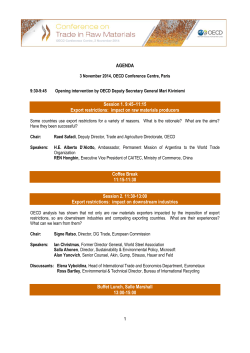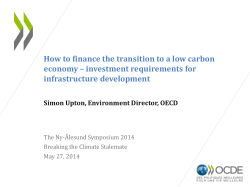
Lower Corporate Taxes: Who Benefits?
Fact Sheet # 4 Lower Corporate Taxes: Who Benefits? T he recent trend of cutting corporate taxes should be reversed. There is a much greater cost to citizens due to lost programs and opportunities than the marginal benefits reaped through corporate tax cuts. Corporations have an obligation to help sustain the public services and physical infrastructure that contribute to their productivity and enable them to generate wealth. The revenue generated by corporate taxes plays an important role in building and maintaining Canada’s physical and social infrastructure. Yet successive cuts in recent years have rendered Canada’s combined federal and provincial corporate tax rates the second lowest among G7 countries, and considerably lower than U.S. rates.25 The case for corporate tax cuts has been made on economic grounds – that tax cuts will enhance economic performance. Yet Canadians are right to wonder: who benefits as corporate bank accounts have swelled and business investment declines? Corporate tax rates have decreased dramatically since 2000 Figure 6: Federal and Provincial Corporate Tax Rates, 2000 and 2014 30% 28.0% Federal Government Corporate Tax Rate 25% Provincial Government Corporate Tax Rate (Average) 20% 15.0% 15% 13.3% 11.4% 10% 5% 0% 2000 2014 Source: OECD Tax Database, Table II.1. http://www.oecd.org/tax/tax-policy/tax-database.htm 11 Percent 60 Figure 7: Canadian Combined Corporate Income Tax Rate (1981-2014) 50.9 50 42.4 40 41.3 26.3 30 20 10 0 1981 1985 1989 1993 1997 2001 2005 2009 2013 Source: OECD, OECD Tax Database. Table II.1. http://www.oecd.org/tax/tax-policy/tax-database.htm; Statistics Canada, CANSIM Table 180-0003 – Financial and taxation statistics for enterprises, by North American Industry Classification System (NAICS), annual Canadians households are picking up the slack • Successive rounds of tax cuts have cost Canadian families dearly by shifting the balance between individual and corporate taxes. In 2014-15, for the first time ever, more than half of the federal government’s revenue is projected to come from personal income taxes, up from a 30% share 50 years ago.26 profits, corporate taxes now make up roughly 14% of federal government revenues, down from over 20% before 1970.27 The overall share of corporate taxes paid to all levels of government is even lower – at 8.3%.28 • Taken together, cuts to corporate taxes since 2007 are costing the federal government up to $13 billion per year in foregone revenue.29 • The share of taxes paid to government by corporations, however, has been trending down. Despite record Figure 8: Federal Government Revenues by Income Source, 2000, 2007, 2014 Q3 2000 Q3 2007 Q3 2014 % change Income taxes 44.5% 47.4% 49.6% 11.3% Corporations and government businesses 15.5% 15.1% 13.9% -10.3% Other sources 40.0% 37.5% 36.5% -8.8% Source: Statistics Canada. Table 380-0080 - Revenue, expenditure and budgetary balance - General governments, quarterly (dollars) 12 Who benefits from corporate tax cuts? • Governments promise that corporate tax cuts will lead to increased economic activity and investment. However, those promises have fallen short. Why? Because record profits sit idle in bank accounts causing foregone tax revenues to undermine the quality of public programs, and further driving a wedge between the wealthy and the rest. • A study that tracked 198 of the top Canadian companies that had year-end data from 2000 to 2009 revealed the companies were making 50% more profit and paying 20% less tax in 2009 than in 2000. What’s more, the number of jobs created by these corporations was actually lower than the average employment growth in Canada.30 • Between 2000 and 2014, a period when corporate taxes fell to record lows (Figure 6), the total cash reserves of private, non-financial corporations grew to $673.5 billion, an increase of nearly 370%.31 • A one percentage point increase in the corporate tax rate would generate $1.85 billion in federal government revenue32 – more than enough to expand the number of high quality child care spaces and the stock of affordable housing units across the country. Since 2000, corporate revenue has been increasingly piling up in bank Figure 9: Total Currency and Deposits of Non-Financial Corporations in Canada ($millions) 2000-2014 $800,000 $700,000 $600,000 $500,000 $400,000 $300,000 $200,000 $100,000 $0 Source: Statistics Canada. Table 378-0121 - National Balance Sheet Accounts, quarterly (dollars) OECD, OECD Tax Database. Table II.1. http://www.oecd.org/tax/tax-policy/tax-database.htm Toby Sanger (2013), “Canada’s (not so incredible) shrinking federal government,” The Progressive Economic Forum, November 20, 2013. http://www.progressive-economics. ca/2013/11/20/canadas-not-so-incredible-shrinking-federal-government/ 27 Ibid. 28 Statistics Canada, CANSIM Table 380-0080 – Revenue, expenditure and budgetary balance, General governments, quarterly (dollars) 29 Jim Stanford (2013), “Good time to rethink corporate tax cuts,” The Progressive Economics Forum, November 14, 2013. http://www.progressive-economics.ca/2013/11/14/good-time-torethink-corporate-tax-cuts/ 25 26 David MacDonald (2011), “Corporate Income Taxes, Profit, and Employment Performance of Canada’s Largest Companies,” Behind the Numbers. Ottawa: Canadian Centre for Policy Alternatives. https://www.policyalternatives.ca/sites/default/files/uploads/publications/ National%20Office/2011/04/Corporate%20Income%20Taxes%2C%20Profit%2C%20and%20 Employment.pdf 31 Statistics Canada, CANSIM Table 378-0121 – Total currency and deposits for non-financial corporations, National Balance Sheet Accounts, quarterly (dollars) 32 Jason Jacques, et al. (2013). Revenue Impacts Arising from Tax Adjust¬ments: 2014. Ottawa: Office of the Parliamentary Budget Officer. http:// www.pbo-dpb.gc.ca/files/files/Ready_ Reckoner_2014_EN.pdf 30 Visit www.cpj.ca to learn more about Citizens for Public Justice, an organization inspired by faith to work for justice in Canadian public policy. © Citizens for Public Justice, May 2015 13
© Copyright 2025

















